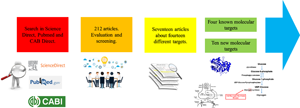Article contents
Molecular targets for the development of new acaricides against Rhipicephalus microplus: a review
Published online by Cambridge University Press: 18 April 2022
Abstract

The cattle tick Rhipicephalus microplus is an ectoparasite with high economic importance to bovine culture, mainly in tropical and subtropical regions. The resistance of the tick from the commercial acaricides has hindered its control, thus motivating the search for new strategies. The purpose of this study was to perform a critical review about the main molecular targets of R. microplus that are useful for the discovery of new acaricides. Bibliographic search was conducted in the databases PubMed, ScienceDirect and CAB Direct, using the following descriptors: ‘Rhipicephalus microplus’, ‘Boophilus microplus’, ‘molecular targets’ and ‘action’, published between 2010 and 2021. Out of the 212 publications identified, 17 articles were selected for study inclusion. This review described 14 molecular targets and among these 4 are targets from commercial acaricides. Most of them are enzymes to catalyse important reactions to tick survival, related to energetic metabolism, mechanisms of biotransformation and neurotransmission. The data will be helpful in the development of new more effective and selective acaricides.
- Type
- Review Article
- Information
- Copyright
- Copyright © The Author(s), 2022. Published by Cambridge University Press
References
- 3
- Cited by



